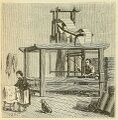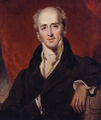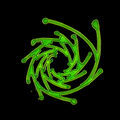Template:Selected anniversaries/December 8: Difference between revisions
No edit summary |
No edit summary |
||
| Line 2: | Line 2: | ||
||1128: "In the third year of Lothar, emperor of the Romans, in the twenty-eighth year of King Henry of the English…on Saturday, 8 December, there appeared from the morning right up to the evening two black spheres against the sun." This description of sunspots, and the earliest known drawing of sunspots, appears in John of Worcester’s Chronicle recorded in 1128. On the night of 13 December 1128, astronomers in Songdo, Korea, witnessed a red vapour that "soared and filled the sky" from the northwest to the southwest. A delay of five days is the average delay between the occurrence of a large sunspot group near the center of the Sun – exactly as witnessed by John of Worcester – and the appearance of the aurora borealis in the night sky at relatively low latitudes *Joe Hanson, itsokaytobesmart.com | ||1128: "In the third year of Lothar, emperor of the Romans, in the twenty-eighth year of King Henry of the English…on Saturday, 8 December, there appeared from the morning right up to the evening two black spheres against the sun." This description of sunspots, and the earliest known drawing of sunspots, appears in John of Worcester’s Chronicle recorded in 1128. On the night of 13 December 1128, astronomers in Songdo, Korea, witnessed a red vapour that "soared and filled the sky" from the northwest to the southwest. A delay of five days is the average delay between the occurrence of a large sunspot group near the center of the Sun – exactly as witnessed by John of Worcester – and the appearance of the aurora borealis in the night sky at relatively low latitudes *Joe Hanson, itsokaytobesmart.com | ||
||1632: Philippe van Lansberge dies ... astronomer and mathematician. | ||1632: Philippe van Lansberge dies ... astronomer and mathematician. Pic. | ||
||1632: Albert Girard dies ... mathematician. He "had early thoughts on the fundamental theorem of algebra" and gave the inductive definition for the Fibonacci numbers. He was the first to use the abbreviations 'sin', 'cos' and 'tan' for the trigonometric functions in a treatise. | ||1632: Albert Girard dies ... mathematician. He "had early thoughts on the fundamental theorem of algebra" and gave the inductive definition for the Fibonacci numbers. He was the first to use the abbreviations 'sin', 'cos' and 'tan' for the trigonometric functions in a treatise. No DOB. Pic: book cover: https://fr.wikipedia.org/wiki/Albert_Girard | ||
||1730: Jan Ingenhousz born ... physiologist, biologist and chemist. He is best known for discovering photosynthesis by showing that light is essential to the process by which green plants absorb carbon dioxide and release oxygen. He also discovered that plants, like animals, have cellular respiration. Pic. | ||1730: Jan Ingenhousz born ... physiologist, biologist and chemist. He is best known for discovering photosynthesis by showing that light is essential to the process by which green plants absorb carbon dioxide and release oxygen. He also discovered that plants, like animals, have cellular respiration. Pic. | ||
||1795: Peter Andreas Hansen born ... astronomer and mathematician born. | ||1795: Peter Andreas Hansen born ... astronomer and mathematician born. Pic. | ||
||1807: Friedrich Traugott Kützing born ... pharmacist, botanist and phycologist ... diatoms v. desmids. | ||1807: Friedrich Traugott Kützing born ... pharmacist, botanist and phycologist ... diatoms v. desmids. | ||
Revision as of 19:53, 23 February 2019
1825: Children reprogram Jacquard loom to compute new family of Gnomon algorithm functions.
1834: Inventor and crime-fighter Charles Grafton Page builds new type of scrying engine.
1835: Charles Grey, 2nd Earl Grey secretly prints first edition of The Adulteration of Bergamot.
1844: Scientist, inventor, and educator Charles-Émile Reynaud born. He will invent the Praxinoscope (an improved zoetrope) and be responsible for the first projected animated films.
1864: Mathematician and philosopher George Boole dies. He worked in the fields of differential equations and algebraic logic, developing Boolean algebra and Boolean logic.
1865: Mathematician Jacques Hadamard born. He will make major contributions in number theory, complex function theory, differential geometry and partial differential equations.
1932: US Navy raises flock of Carnivorous dirigibles.
1955: Mathematician, physicist, and philosopher Hermann Weyl dies. He was one of the most influential mathematicians of the twentieth century: his research has major significance for theoretical physics as well as purely mathematical disciplines including number theory.
2001: Pioneering computer scientist and programmer Betty Holberton dies. She was one of the six original programmers of ENIAC, the first general-purpose electronic digital computer, and was the inventor of breakpoints in computer debugging.
2016: Green Spiral 5 voted Picture of the Day by the citizens of New Minneapolis, Canada.









